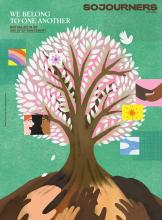I WROTE MY first “Eyes and Ears” column in January 1987 when I was a Sojourners staff editor. Over the ensuing years, I’ve changed from Protestant to Catholic, from full-time journalist to full-time teacher, and from city mouse to country mouse. I’ve been married to Polly Duncan Collum and helped raise four children. Through all that, I’ve kept this column going, but now I’m pulling the plug to make way for whatever’s next.
In my first column, I set out a twofold purpose for this space. I intended to track the merger of politics and popular culture that began in earnest with the 1980 election of a movie star president. I noted then that our public life was largely being reduced to an “ephemeral community of shared media experience,” by which, at the time, I meant mostly Hollywood movies and various televised spectacles.
By the time we elected a reality TV star as president, the convergence of politics and popular culture was already long complete, except that, in a world of microtargeted messaging, there is no longer even much “shared media experience” from which to forge a community.
My second rationale for starting the column, however, has held up a little better. I noted way back then that, in both politics and popular culture and in the intellectual netherworld of think tanks and commentary journalism, the very definitions of terms such as “America,” “democracy,” and “Christianity” were up for grabs. In 1987, I called this a “war of ideas” and it continues with a vengeance, though often degenerating into an emotional war of identities.
However, “stuff happens.” And in these 35 years, two big things have happened that exploded many of my expectations and drastically altered the cultural landscape.
Read the Full Article

